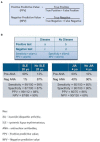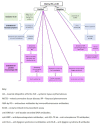Reliability and reproducibility of antinuclear antibody testing in pediatric rheumatology practice
- PMID: 36714114
- PMCID: PMC9875300
- DOI: 10.3389/fmed.2022.1071115
Reliability and reproducibility of antinuclear antibody testing in pediatric rheumatology practice
Abstract
Antinuclear antibody (ANA) testing is common practice among health care practitioners when evaluating children and adolescents with non-specific symptoms including fatigue and aches and pains. When positive, ANA results often lead to referrals to pediatric rheumatologists as these antibodies may be key indicators for specific pediatric rheumatologic diagnoses. The reliability and reproducibility of ANA tests varies with assay techniques and validation and interpretation of results. In the following article, review of ANA testing in pediatrics is provided along with case examples that demonstrate the reliability and reproducibility of these results in specific scenarios common in the practice of pediatric rheumatology. Guidelines for more accurate utilization of ANA testing are presented with the aim to improve testing and interpretation by ordering clinicians.
Keywords: Juvenile Idiopathic Arthritis; antinuclear antibodies; immunofluorescence assay; multiplex assay; pediatric rheumatology; pediatric systemic lupus erythematosus; reliability; reproducibility.
Copyright © 2023 Ostrov.
Conflict of interest statement
The author declares that the research was conducted in the absence of any commercial or financial relationships that could be construed as a potential conflict of interest.
Figures
Similar articles
-
Using Antinuclear Antibody Testing in Pediatric Rheumatology.Clin Pediatr (Phila). 2025 Jan;64(1):125-130. doi: 10.1177/00099228241254232. Epub 2024 May 20. Clin Pediatr (Phila). 2025. PMID: 38767305
-
Significance of the immunofluorescence staining patterns and titres of the antinuclear antibody test in paediatric rheumatology setting.Turk J Med Sci. 2023 Feb;53(1):193-198. doi: 10.55730/1300-0144.5572. Epub 2023 Feb 22. Turk J Med Sci. 2023. PMID: 36945955 Free PMC article.
-
Antinuclear antibody testing in a Turkish pediatrics clinic: is it always necessary?Pan Afr Med J. 2019 Apr 11;32:181. doi: 10.11604/pamj.2019.32.181.13793. eCollection 2019. Pan Afr Med J. 2019. PMID: 31312295 Free PMC article.
-
[Modern look at the problems of investigation of antinuclear antibodies in systemic lupus erythematosus (literature review).].Klin Lab Diagn. 2018;63(6):340-348. doi: 10.18821/0869-2084-2018-63-6-340-348. Klin Lab Diagn. 2018. PMID: 30702224 Review. Russian.
-
ANA as an entry criterion for the classification of SLE.Autoimmun Rev. 2019 Dec;18(12):102400. doi: 10.1016/j.autrev.2019.102400. Epub 2019 Oct 19. Autoimmun Rev. 2019. PMID: 31639513 Review.
Cited by
-
InTiCAR: Network-based identification of significant inter-tissue communicators for autoimmune diseases.Comput Struct Biotechnol J. 2025 Jan 10;27:333-345. doi: 10.1016/j.csbj.2025.01.003. eCollection 2025. Comput Struct Biotechnol J. 2025. PMID: 39897058 Free PMC article.
-
Should We Adopt Increased Dilutions for Indirect Immunofluorescence in Pediatric Anti-Centromere Antibody Testing? Insights from a Three-Year Retrospective Study.Children (Basel). 2024 Dec 28;12(1):36. doi: 10.3390/children12010036. Children (Basel). 2024. PMID: 39857867 Free PMC article.
-
Diagnostic challenge: Juvenile bullous pemphigoid with a negative BP180 ELISA.Pediatr Dermatol. 2025 Mar-Apr;42(2):342-345. doi: 10.1111/pde.15741. Epub 2024 Aug 21. Pediatr Dermatol. 2025. PMID: 39168501 Free PMC article.
-
National Registry for Childhood Onset Scleroderma I: Insights from the first 341 juvenile localized scleroderma patients.J Scleroderma Relat Disord. 2024 Sep 23:23971983241272460. doi: 10.1177/23971983241272460. Online ahead of print. J Scleroderma Relat Disord. 2024. PMID: 39544906 Free PMC article.
References
-
- Deane PM, Liard G, Siegel DM, Baum J. The outcome of children referred to a pediatric rheumatology clinic with a positive antinuclear antibody test but without an autoimmune disease. Pediatrics. (1995) 95:892–5. - PubMed
Publication types
LinkOut - more resources
Full Text Sources



